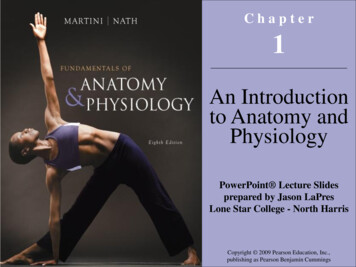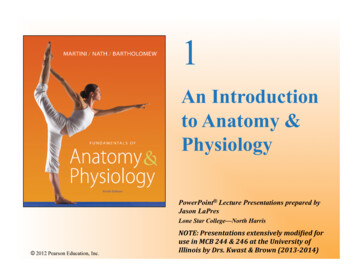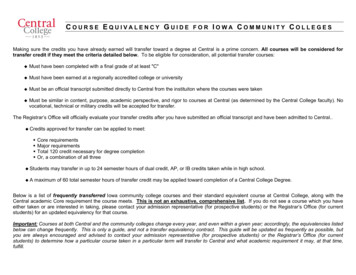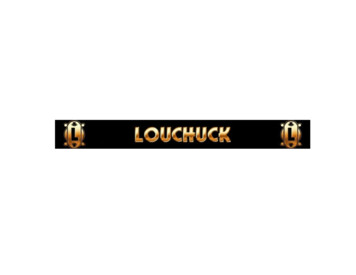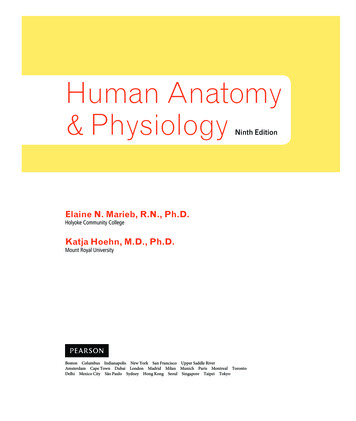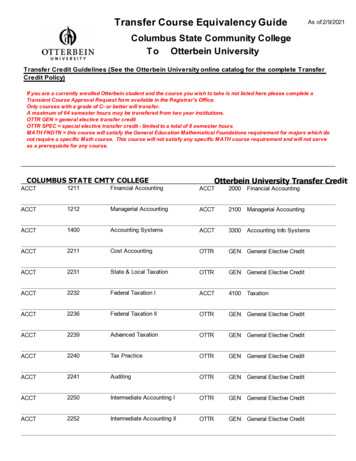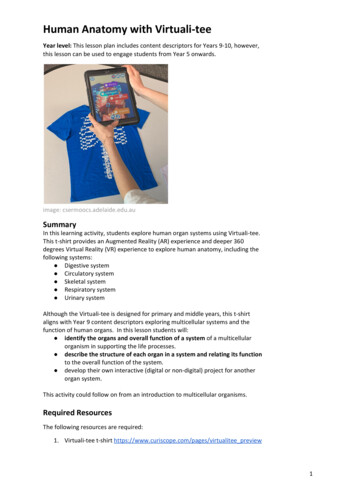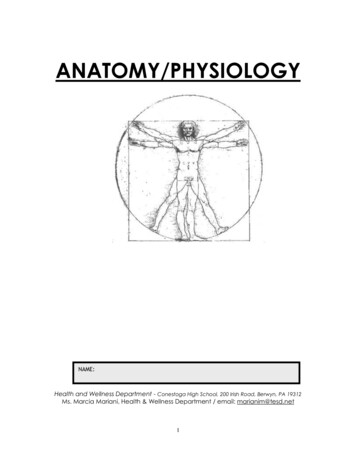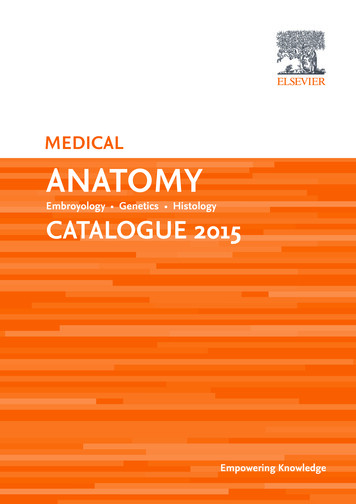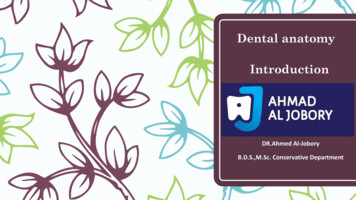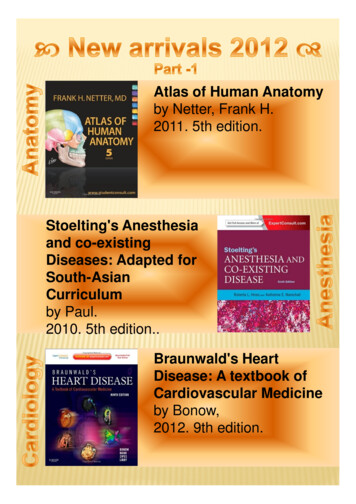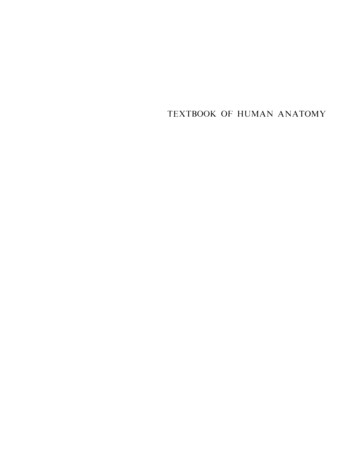
Transcription
TEXTBOOK OF HUMAN ANATOMY
ContributorsThe late Sir Wilfred E Le Gros Clark,MA, MD, DSe, LLD, FRCS, FRSProfessor of Anatomy, University of OxfordR E Coupland, MD, PhD, DSe, FRSEPrf!fessor f!fHuman Morphology, University f!f NottinghamT W Glenister, TO, DSe, MB, BS, PhDProfessor of Anatomy, Charing Cross Hospital Medical School,University of LondonThe late W JHamilton, MD, BCh, DSe, FRSE, FRCOG, FRCSPrf!fessor Emeritus, University of LondonJ Joseph, MD, DSe, FRCOGProfessor of Anatomy, Guy's Hospital Medical School,University of LondonR M H McMinn, PhD, MD, FRCSPrf!fessor f!fAnatomy, Royal College f!f Surgeons of EnglandR J Scothorne, BSe, MB, ChB, MD, FRCSRegius Professor f!f Anatomy,- University f!f GlasgowD Sinclair, MA, DSe, MD, FRSEDirector, Postgraduate Medical Education, Queen Elizabeth I I MedicalCentre, Western Australia. Formerly Professor of Anatomy,University of AberdeenJ M Yoffey, DSc, MD, FRCS, Hon LLDProfessor Emeritus, University of BristolVisiting Professor, Hebrew University of Jerusalem
Textbook ofHUMAN ANATOMYSecond EditionEdited by the late W J HAMIL TONM
W. J.Hamilton, 1976All rights reserved. No part of this publication maybe reproduced or transmitted, in any form or by anymeans, without permissionFirst Edition, 1956Second Edition, 1976Reprinted, 1977, 1982Published byTHE MACMILLAN PRESS LTOLondon and BasingstokeCompanies and representatives throughoutthe worldISBN 978-0-333-34029-5ISBN 978-1-349-06486-1 (eBook)DOI 10.1007/978-1-349-06486-1The paperback edition of this book is sold subject to thecondition that it shall not, by way of trade or otherwise, belent, resold, hired out, or otherwise circulated withoutthe publisher's prior consent, in any form of binding orcover other than that in which it is published and withouta similar condition including this condition beingimposed on the subsequent purchaser.
PREFACE TO THESECOND EDITIONAs the proofs of this book were in the press, the sudden deathof Professor W. J. Hamilton deprived British anatomy, andindeed anatomy throughout the world, of one of its outstanding personalities. Some time previously, he had decidedthat when this Second Edition was published he would retirefrom the Editorship and he had asked us to take over thepreparation of any further editions. So it came about that wefind ourselves writing a preface that should rightly be his, forthe whole concept of this edition was his and it is only thefinal printing that he has not lived to see.For this edition there are new contributors and a new twocolumn format has been adopted. Some of the chapters havebeen extensively revised and the others have been entirelyre-written, the terminology conforming in general withNomina Anatomica. While many of the former figures havebeen retained, the labelling has been carefully revised to makethem more readable and more pleasing to the eye. In thisrespect, considerable attention has been paid to the layout ofthe illustrations. Many new figures have been added and thequality of the draftsmanship displayed by the late A. K.Maxwell and by Frank Price is outstanding; all readers ofthis book must be indebted to them, and as editors-designatewe gladly acknowledge our own debt.Although Anatomy is a scientific discipline in its own right,the contributors have borne in mind that this is a bookdesigned for those who are preparing for careers in medicine(using that term in its broadest sense), and frequent referencehas been made to the clinical and applied aspects of the subject.This is not to say that everything included in the text is ofeveryday clinical significance; enough anatomical knowledgehas been included for the student to appreciate how the bodyis, and has come to be, constructed and how the variousstructures of which it is composed are designed to performtheir functions. Sufficient microscopical and developmentalanatomy has been included to allow integration withtopographical anatomy.Where illustrations have been reproduced with the permission of the authors and publishers, or are based on thosealready published elsewhere, due acknowledgement is madein the accompanying legend. If, by oversight, any suchacknowledgements have been omitted, we offer our apologiesand ask the indulgence of any offended party, as it has beenparticularly difficult to ensure that no such omissions haveoccurred, much of the required information having disappeared with the death of Professor Hamilton.On behalf of the late Professor Hamilton, it is our pleasureto thank our colleagues for their contributions. ProfessorJack Joseph has kindly undertaken the onerous task ofpreparing the index and we are particularly grateful to Mr.Charles Fry, of the Macmillan Press Ltd., who has done somuch to see the completion of this edition through its variousstages of production and without whose help it would havebeen difficult, if not impossible, to complete the proof stagesafter the Editor's death. Lastly, but not least, we express ourgratitude to the sons of Professor Hamilton who kept theimpetus going after the loss of their father.We trust that this volume will be a worthy and lastingtribute to the man whose concept it was.London,January 1976.T.W.G.R.M.H.McM.
PREFACE TO THEFIRST EDITIONIs there need for yet another Textbook of Anatomy? Webelieve there are three major reasons why such a book isrequired.The first arises from the progressive expansion of themedical curriculum. This makes it essential to reduce theamount of factual knowledge which the medical student iscalled upon to acquire. However, while most of us wouldaccept the desirability of this aim, the task of eliminatinganatomical detail presents a serious difficulty. We tend toemphasize the clinical significance of anatomical facts, mostof which may on occasion be of practical importance. Butsome facts are either used more frequently or possess fargreater importance than others, and it thus becomes essentialto establish a scale of values in order that the medical studentmay view his anatomical knowledge in its correct perspective.It is this which constitutes the essence of the problem. If it isinsisted that medical students should be prepared for everypossible clinical contingency (even difficult major operations),the omission of much detail will never be possible. But evenwhere there is a genuine wish to omit, the assessment of therelative significance of anatomical data is determined to anappreciable extent by individual experience and is consequently a somewhat subjective process. It is therefore noteasy to secure a common measure of agreement on how muchtopographical detail to exclude and, when discussing theproblem amongst ourselves or with our colleagues, it hasalmost been a case of quat homines tot sententiae.We have curtailed much of the detailed anatomy on thebones of the skull as considered separately in disarticulatedform, and also on the separate carpal and the tarsal bones.We have similarly abbreviated the account of the smallerbranches of blood vessels. In addition, it will be found thatthere has been a certain amount of pruning of what may beconsidered to be topographical minutiae throughout mostsections of the book.Our second reason for writing a new Textbook1s the needfor a closer correlation between the study of structure andfunction. It is a regrettable fact that while all those who areconcerned with medical education are agreed on the need forgreater integration between the different branches of themedical curriculum in general, and anatomy and physiologyin particular, this attitude has not yet been reflected to anygreat extent in students' textbooks. We have thereforeattempted to stress this aspect of anatomy rather moreforcibily than is the case in the existing standard textbooks.The use of radiological methods in anatomical teachinghas inevitably meant a more functional approach to the studyof many parts of the body, notably the thoracic andabdominal viscera. The observation of changing structureduring life becomes inseparable from the study of function,and indeed unintelligible without it. Further, in the field ofexperimental anatomy the light which has been thrown onmorphogenetic and histogenetic mechanisms has again servedto direct attention to tissues which are alive and capable ofchange rather than on dead and fixed material.In the present volume it has been mainly in the centralnervous, endocrine, and cardiovascular systems than an efforthas been made to break down the artificial barriers whichhave hitherto existed between anatomy and physiology. Tothe same end, the bony elements of the skeleton are considered together with the joints and muscles, so that the studentapproaches the study of the locomotor system as a whole.The third reason is that anatomy is not merely part of themedical curriculum, but also an independent branch of biological science with problems and achievements of its own.We feel it is important that, however briefly and sketchily,the student should be introduced to the wider biologicalimplications of his anatomical studies, and that he should beinduced to realize that what he is learning is significant fromother than purely vocational points of view.In many departments of Anatomy it is now customary tointegrate the teaching of macroscopic with microscopicanatomy. We believe that the intimate relationship betweenthe two aspects of anatomy is apt to be overlooked if thestudent is not constantly reminded how closely they are interlinked. A brief account is therefore given of this histologicalappearance of the different organs and tissues. No attempt ismade in this book to give a systematic and detailed reviewof embryological development. Brief references to embryologyare made only where it helps to elucidate some particularaspect of gross or microscopic anatomy.Without sacrificing any of the topographical informationwhich will always be essential for the non-specialist medicalpractitioner, we believe that this book covers the field ofanatomical knowledge which the medical student is expectedto have acquired by the end of his pre-clinical course. Whiledesigned primarily for medical students, it should also be ofvalue to students of physiotherapy, radiotherapy, dentistry andphysical education, as well as biologists generally.Though the book in its present form may have realizedimperfectly the aims with which we set out to write it, wehope that it will meet a need which we are sure exists, andwhich is bound to make itself felt with added force in thefuture.
CONTENTSINTRODUCTION W J Hamilton and J M Y offeyThe Scope of AnatomyAnatomical NomenclatureMethods of StudyNormal Anatomy and Individual Variations4BLOOD AND CONNECTIVE TISSUE5Constituent Elements of Connective TissueBlood and Blood-Forming OrgansBlood FormationCell UltrastructureLOCOMOTOR SYSTEM J Joseph11259141619GeneralEvolution of Locomotor System of ManThe Human Skeletal PatternChanges in the Mechanics of Locomotion19202123CARTILAGE AND BONE24CartilageBone2526JOINTS35Synovial JointsCartilaginous and Fibrous JointsDevelopment of and Changes in JointsRadiological Appearances of Joints36MUSCLES38Functional Aspects of Contracting Muscle42FASCIA43VERTEBRAL COLUMNCervical VertebraeThoracic VertebraeLumbar VertebraeSacrum and CoccyxIntervertebral DiscsJoints of the Vertebral ColumnThe Vertebral Column as a WholeMovements of Vertebral Column383838Development, Ossification and Growth of theVertebral ColumnStructural Variations of the Vertebral Column5152THORAX53RibsSternumCostal CartilagesMovements of the Chest Wall5355555656SKULL58Skull from aboveSkull from belowSkull from in frontSkull from the sideCranial CavityNasal CavityParanasal SinusesThe Separate Bones of the SkullDevelopmentTemporomandibular JointAge Changes in the SkullVariations in the Form of the Skull59606262666870fu UPPERLIMB BONESandtheirAND JOINTS7082838484Shoulder Girdle and HumerusJoints of Shoulder Girdle and Glenohumeral JointMovements of Shoulder GirdleBones of the Forearm, Wrist and HandJoints of the Elbow, Wrist and Hand8491929410143LOWER109454646Pelvic GirdlePelvis as a WholeMeasurements of the Female PelvisSex Differences in the PelvisJoints of the PelvisFemur and Hip JointBones of the Leg and Knee JointSkeleton of the Foot4747485050LIMB BONESAND JOINTS109113114115116117123130
MYOLOGY138Fascia and Muscles of the TrunkMuscles of the HeadFascia and Muscles of the NeckFascia and Muscles of the Upper LimbFascia and Muscles of the Lower Limb138154158163179MAN'S POSTURE196LOCOMOTION198DIGESTIVE SYSTEM W J Hamilton and R M HMcMinn329ALIMENTARY CANAL329201General Structure of the Alimentary CanalDevelopment of the Digestive SystemMouthDental Arches and 44350358GENERAL ARRANGEMENT201ABDOMINAL AND PELVIC CAVITIES361Heart: Pulmonary and Systemic CirculationNetwork of Blood VesselsStructure of the ArteriesFunction of the Arterial WallStructure of the CapillariesStructure of VeinsAnastomosis and Collateral CirculationGrowth of Blood VesselsInnervation of Blood VesselsVitelline and Placental CirculationGeneral Development of the Heart and Great VesselsFetal CirculationExamination of Living Blood ons of the 395PANCREAS403HEART AND PERICARDIUM225General Configuration of the HeartInterior of the HeartTissues of the HeartExamination of the Living Heart225227233239BLOOD VESSELS242AortaDescending Thoracic Aorta242258VEINS270Veins of the Head and NeckVeins of the Upper LimbSuperior Vena Cava and its Drainage AreaVeins of the Lower LimbInferior Vena Cava and its Drainage AreaPortal Vein and its Tributaries270275277L YMPHA TIC SYSTEM279Lymphatic VesselsLymph Node Disposition, Structure and Relation toLymph VesselsMain Collecting Lymphatic Channels279CARDIOV ASCULAR SYSTEMJ M YoffeyRESPIRATORY SYSTEM J M YoffeyTHE RESPIRATORY PASSAGESNoseNasal CavityNasal PharynxLarynxTrachea and 302303314315318UROGENITAL SYSTEM T W Glenister405General Disposition of the Organs of Excretion andReproduction405Phylogenetic and Ontogenetic Considerations407Homologues of the Organs of Reproduction410Kidneys410Ureters423Urinary Bladder426Urethra433FEMALE REPRODUCTIVE ORGANS435OvariesOvarian CycleUterine TubesUterusVaginaVulva, or External Genitalia of FemaleMammary Gland435436441444453455456MALE REPRODUCTIVE ORGANS461Testis and EpididymisSpermatic CordDuctus (Vas) DeferensSeminal VesiclesProstateExternal Genitalia of the Male461469470ENDOCRINE SYSTEMR E Coupland472473478481Pituitary Gland (Hypophysis Cerebri)482Pineal BodyThyroid GlandParathyroid GlandsThymusEndocrine Islets of the PancreasAdrenal (Suprarenal) Glands487488492493495497SPLEEN J M Y offey501
CENTRAL NERVOUS SYSTEMW E Ie Gros Clark 505Anatomy of the NeuronAnatomy of the Reflex ArcGeneral Plan of Central NervousSystemGeneral Connections of BrainSpinal Cord and its Membranes506511THE BRAIN533Main Features of the Internal Structure of the BrainStemNuclei of Cranial NervesAscending Tracts in the Brain StemDescending Tracts in the Brain StemAssociation Tracts of the Brain StemCerebellum538540550552553553512518521THE FOREBRAIN (PROSENCEPHALON)Cerebral CortexSensory Systems of Thalamus and CortexAuditory SystemVisual SystemOlfactory SystemGustatory SystemMotor and Premo tor Areas of CortexCorpus StriatumAssociation Fibres of Cerebral CortexAssociation Areas of Cerebral CortexCommissural Connections of Cerebral CortexVentricular System and Circulation ofCerebrospinal FluidIntracranial Dura MaterArterial Supply of the BrainVenous Drainage of BrainPERIPHERAL NERVOUS 7601R J Scothorne 603Structure of Peripheral Nerve Fibres and Nerves606Nerve TerminationsNerve ComponentsDistribution of Cranial Nerves614616SPINAL NERVES637Roots of the Spinal NervesPrimary Rami of Spinal NervesCervical PlexusBrachial PlexusVentral Primary Rami of the Thoracic NervesLower Five Intercostal and Subcostal NervesVentral Primary Rami of Lumbar, Sacral andCoccygeal NervesLumbar PlexusSacral Plexus637640642643655657AUTONOMIC NERVOUS SYSTEM667Sympathetic and Parasympathetic DivisionsSympathetic DivisionParasympathetic Division670670680ORGANS OF THE SPECIAL SENSESA M Hamilton682Organ of SightEyeballEyebrows and EyelidsOrgan of HearingThe Skin682683694696706GROWTHD SinclairGrowth CurvesGrowth of the Body as a WholeCross-Sectional Growth StandardsGrowth of SystemsMaturationFactors Influencing Growth and 9
TEXTBOOK OF HUMAN ANATOMY . Contributors The late Sir Wilfred E Le Gros Clark, MA, MD, DSe, LLD, FRCS, FRS Professor of Anatomy, University of Oxford . Development of and Changes in Joints Radiological Appearances of Joints MUSCLES Functio
